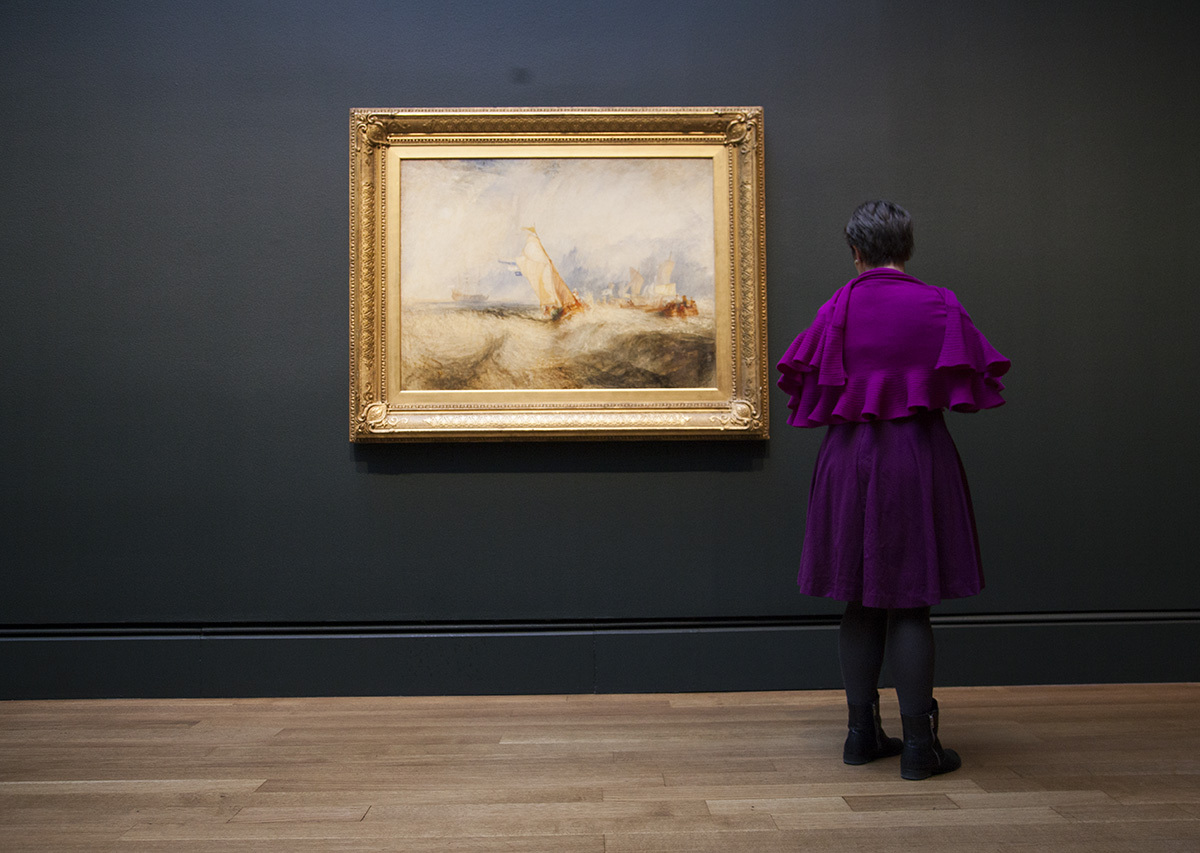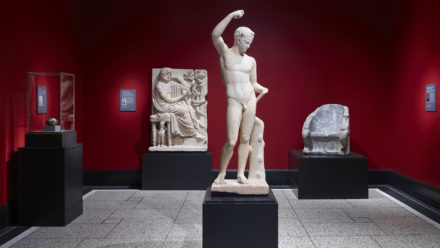
As public spaces around the world shut down in response to the growing COVID-19 pandemic, museums suddenly faced an unprecedented future. With visitors unable to stroll the galleries, staff barred from working onsite, planned exhibitions canceled or postponed indefinitely, and in some cases, staggering financial losses, a cloud of uncertainty hangs over each museum.
What is a museum’s place in a world grappling with a global health crisis? From the day they shut their doors, museums have been forced to confront this question as they work to protect their staff and the future of their institutions.
J. Paul Getty Trust President and CEO James Cuno gathered six museum directors from around the country for a candid discussion about how they’re coping with the challenges of the COVID-19 crisis.
Listen to the Art + Ideas podcast to discover how leaders of iconic museums are contending with the financial implications of closing their doors, their re-opening strategies, unexpected digital growth, and the important role they believe museums can play in a post-COVID-19 world.
Listen to part 1 of the conversation here and part 2 here.
Financial Losses and a Challenging Future
The directors said they became aware of the growing threat of COVID-19 in much the same way as the rest of the world—from coming to terms with the virus’ danger in a more abstract way, to realizing the health risks to staff and museum visitors.
That focus on protecting staff’s health, along with the reality that museums are public gathering places that could pose a threat to their communities, ultimately guided their decisions to close.
“We closed, and then it’s entirely been about taking care of the staff. And with that as our sort of North Star, it’s really helped in decision-making,” said Kaywin Feldman, director of the National Gallery of Art.
Without knowing when state and local officials will lift “stay at home” orders and when testing, treatment, or a vaccine will allow museums to reopen, the directors have been balancing their desire to compensate all employees throughout this uncertain time while grappling with the financial implications of remaining closed.
Director of the Metropolitan Museum of Art, Max Hollein, said he felt it was important to publicly announce that the Met would lose about $100 million up through the end of this year so people would understand the magnitude of what they were facing. Matthew Teitelbaum, director of the Museum of Fine Arts, Boston, said furloughing over 300 MFA employees helped achieve his goal of keeping all staff at their current compensation level with full health benefits, but acknowledged that a furloughed employee may still feel a sense of loss, lack of respect, and anxiety.
However, the uncertainty of the future makes any decisions about budgeting and reopening challenging.
“You need to make decisions based on the facts you have, and we don’t know two major things. We don’t know when we’re going to open, and we don’t know whether our proposition for our audiences is going to be appealing to them, so we can’t actually set our attendance targets. And we are, to some degree, quite dependent on attendance for revenue,” Teitelbaum said.
While some of the directors admitted they had optimistic re-opening dates in mind soon after closing, all agreed that at this point they can’t accurately predict how long the crisis would last and when they might be able to welcome visitors back. Hollein also said that he wanted to be sensitive about the message it would send to the community if a large cultural institution like The Met made any predictions about the length of the crisis, positive or negative.
“We were pretty much the first larger-scale institution in New York City to make that decision [to close]. Broadway and everything else closed only after that. So we didn’t want to send a disastrous message about everything in New York,” Hollein said. “We just wanted to have a decision where safety for our staff and our visitors at The Met was first, and then have New York come to its own conclusions.”
Digital Engagement Skyrockets
While the directors wait until it’s safe to reopen, reschedule exhibitions, and bring staff back on site, several noted that their museums have been pushed to experiment with digital engagement, growing their virtual audiences by leaps and bounds. (Hammer Museum director Ann Philbin noted that many of the programs Hammer has published online received four or five times the audience they had in their 300-seat theater.) This renewed focus on expanding museums’ online presence won’t disappear when the doors reopen.
“This will become, I think, a much more central part of what museums can do and will want to do, and another dimension, a whole new dimension of the experience of art and culture for all people around the world,” said Timothy Potts, director of the J. Paul Getty Museum.
Challenges and Rewards of Reopening
While audiences have responded enthusiastically to virtual connections to art, what will museums’ place in society be once the doors are open again? Certainly, social distancing measures such as masks, limited crowds, and canceling of larger events will, in the short term at least, change the typical museum-going experience. Director of the Art Institute of Chicago, James Rondeau, said he believed their most important job when they reopen will be to try to rebuild public trust in shared social spaces and to help their communities understand that the art museum experience is productive, safe, secure, and rewarding.
“How do we try to make clear that we want to return to what we’ve always been? How do we return as a full civic partner to rebuilding notions of shared social space? Not just for art museums, but for our cities and for our world,” Rondeau said. “So something I wanted to try to really move away from is the notion of our museums as places of quietude or retreat.”
Philbin also pointed out that one of the hardest-hit groups is the artist community—the community that immediately lost their infrastructure of support, such as performance spaces, galleries, and museums that are closed for an indeterminate future.
Any revival of museums will have to include efforts to help get artists back on their feet, Philbin noted.
“Artists are going to probably be the first ones to articulate how we’re going to return to life. And they will be the ones we follow. But right now, they’re in a very bad state,” Philbin said. “At some point when we all save our institutions and our staff, I think that’s something that we need to start looking at: how can we help the artists?”
But there was a sense of hope among the directors, and a shared belief that while the museum-going experience may look a bit different, people’s desire to come together and connect with others over art will remain, both in physical and virtual spaces.
“If we can figure out the social distancing, if we can figure out how to express why people should trust that we are a safe place to gather, we have extraordinary potential to play an increased role in mending and repairing our communities. I feel that deeply,” Teitelbaum said. “And I think that will be one of the legacies, that we will find an even louder and prouder voice.”




Thank you for your brilliant “Getty Challenge”. I have been painting stones (my neighbour kindly told me I have unlimited access to the river rocks in her garden) and distributing them around the neighbourhood. They make a bit of a treasure hunt for children. In Ontario, Canada, we have been allowed to go out for exercise, which is a blessing for parents.
I will not call my stones “art” but they have kept me busy crafting with purpose. You can find me on Facebook if you want to see some of the creations.
Take care, Getty Museum people. I hope to visit you again one day.
I greatly appreciate the Google Arts and Culture platform. By enlarging one of the exhibited pieces I can learn a great deal. However the photographs provide a limited experience. Especially with three dimensional objects (sculpture and ancient pottery), I miss the opportunity to examine them from various angles. As good as the on-line experience is, I need to visit the museums.
Nothing has highlighted the need for a learning society quite so much as has this pandemic. Every nation’s population is being tested with respect to its ability to absorb and integrate new information. While governments have tended to slip museums and other cultural attractions into the categories of recreational and cultural attractions, widespread school closures have brought these institutions into the forefront of public education.
Prior to this pandemic, the conventional reasoning regarding museums, libraries, zoos, botanic gardens, historic sites and the like tended to be that these were informal learning experiences that could augment classroom-based curriculum and instruction. At this point, however, almost all students – from children to adults – are denied access to classroom instruction, and the informal experiences provided on-line by museums and others are gaining new attention and reaching new audiences. Will this result in new perceptions of the role of museums in state and national education standards? What could be/should be done to secure such perceptions? And further, how might museums secure a permanent “place at the table” in curriculum development processes? …and a permanent place in the overall education budget?
The recent NY Times article about reopening and probability of various businesses suggests that museums are among the least likely spots to get infected. I wish LA would consider this in deciding how to proceed. https://www.nytimes.com/interactive/2020/05/06/opinion/coronavirus-us-reopen.html?smid=fb-share&fbclid=IwAR3EkP226sa_iZu85qOXz-aAEm4y_iDBdapyVSqrMIdXi8lbPVnN515EHl4